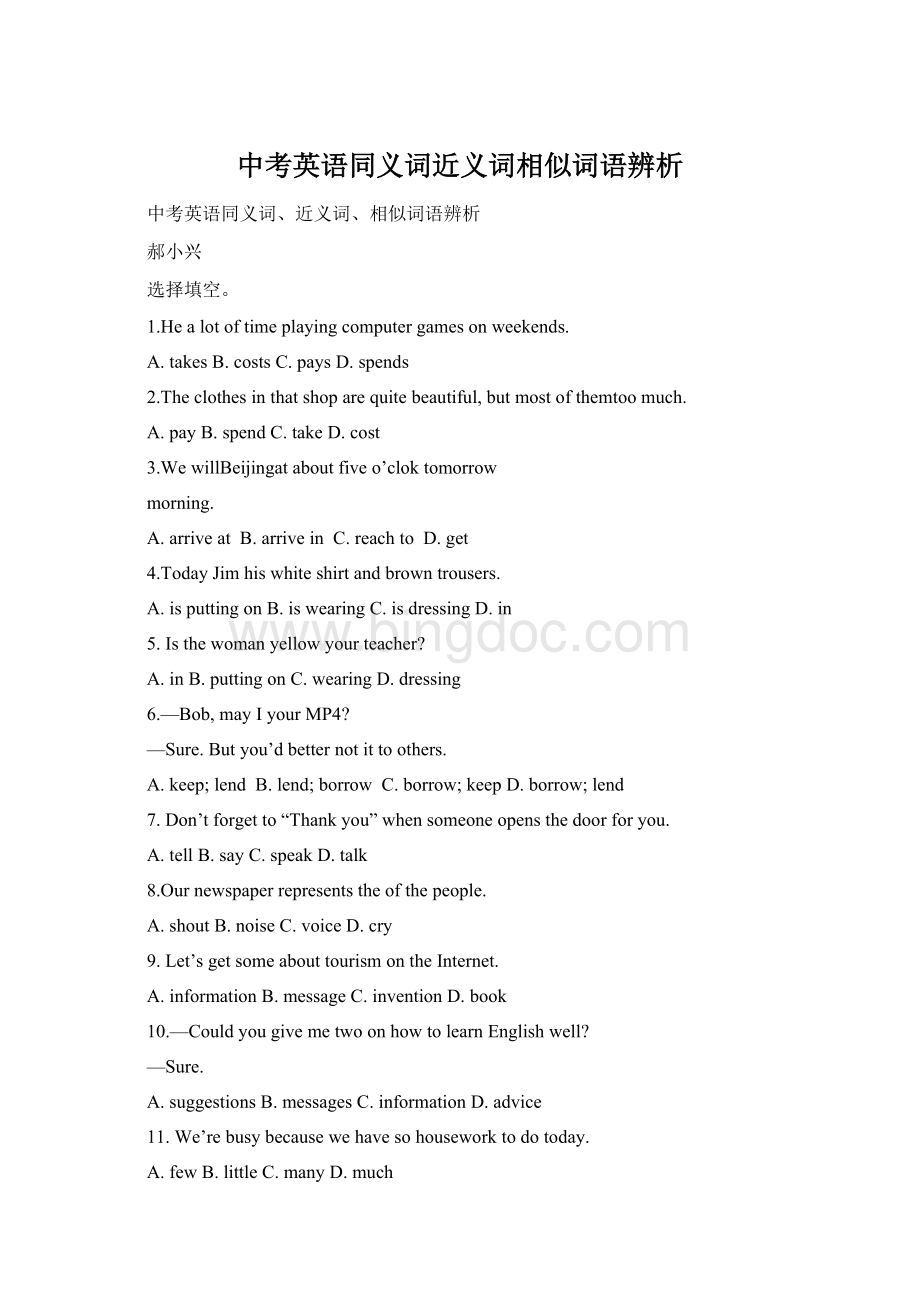 中考英语同义词近义词相似词语辨析.docx
中考英语同义词近义词相似词语辨析.docx
- 文档编号:7503488
- 上传时间:2023-05-11
- 格式:DOCX
- 页数:8
- 大小:21.62KB
中考英语同义词近义词相似词语辨析.docx
《中考英语同义词近义词相似词语辨析.docx》由会员分享,可在线阅读,更多相关《中考英语同义词近义词相似词语辨析.docx(8页珍藏版)》请在冰点文库上搜索。

中考英语同义词近义词相似词语辨析
中考英语同义词、近义词、相似词语辨析
郝小兴
选择填空。
1.Healotoftimeplayingcomputergamesonweekends.
A.takesB.costsC.paysD.spends
2.Theclothesinthatshoparequitebeautiful,butmostofthemtoomuch.
A.payB.spendC.takeD.cost
3.WewillBeijingataboutfiveo’cloktomorrow
morning.
A.arriveatB.arriveinC.reachtoD.get
4.TodayJimhiswhiteshirtandbrowntrousers.
A.isputtingonB.iswearingC.isdressingD.in
5.Isthewomanyellowyourteacher?
A.inB.puttingonC.wearingD.dressing
6.—Bob,mayIyourMP4?
—Sure.Butyou’dbetternotittoothers.
A.keep;lendB.lend;borrowC.borrow;keepD.borrow;lend
7.Don’tforgetto“Thankyou”whensomeoneopensthedoorforyou.
A.tellB.sayC.speakD.talk
8.Ournewspaperrepresentstheofthepeople.
A.shoutB.noiseC.voiceD.cry
9.Let’sgetsomeabouttourismontheInternet.
A.informationB.messageC.inventionD.book
10.—CouldyougivemetwoonhowtolearnEnglishwell?
—Sure.
A.suggestionsB.messagesC.informationD.advice
11.We’rebusybecausewehavesohouseworktodotoday.
A.fewB.littleC.manyD.much
12.Thereismilkathome.Wehavetobuysomethisafternoon.
A.alittleB.littleC.afewD.few
13.—I’dlikegrapesandpears.
—Oh,Ionlyneedorangejuice.
A.some;afewB.afew;someC.alittle;fewD.alittle;afew
14.IinvitedJoeandLindatodinner,butofthemcame.
A.neitherB.eitherC.noneD.both
15.—There’scoffeeandtea;youcanhave.
—Thanks.
A.eitherB.eachC.oneD.it
16.“Havetry,youaresoclosetotheanswer,”theteachersaidtoEric.
A.theotherB.oneanotherC.otherD.another
17.Mysisterhastwoskirts.Oneisyellow;isblack.
A.otherB.anotherC.othersD.theother
18.Wedon’thaveenoughnursestolookafterthepatients.Atleastareneeded.
A.tnanothernursesB.moretennurses
C.othertennursesD.anothertennurses
19.Samlookslikehisdad.Theyaretall.
A.eitherB.anyC.allD.both
20.—WhichofthetwoT-shirtswillyoutake?
—I’lltake,oneformybrother,theotherformyself.
A.eitherB.neitherC.allD.both
21.—Whatthenumberofthestudentsinyourschool?
—Abouttwothousands.AnumberofthemfromEngland.
A.is;areB.is;isC.are;isD.are;are
22.theteachersintheirschoolisabout200andonefourthofthemareteachers.
A.Anumberof;womenB.Anumberof;woman
C.Thenumberof;womenD.Thenumberof;woman
23.—Guesshowmuchitcosts?
—Ithinkitcosts15and20dollars.
A.fromB.betweenC.amongD.with
24.—Whatdoyouoftendoclassestorelaxyourself?
—Listentomusic.
A.overB.amongC.betweenD.through
25.—Thecakelooks.
—Yes,andittasteseven_______.
A.well;goodB.nice;betterC.good;worseD.better;best
26.Ididn’tsleep______lastnight.Ifeeltirednow.
A.wellB.niceC.fineD.good
27.—_______doyouvisityourgrandparents?
—Onceaweek.
A.HowlongB.HowoftenC.HowsoonD.Howmany
28.—_______willthe30thLondonOlympicGamesbeheld,doyouknow?
—Intwoyears.
A.HowlongB.HowoftenC.HowsoonD.Howmuch
29.—Granny,youlooksoweak.What’swrongwithyou?
—Terrible.Thefactorymade_______noise.Itwas______noisythatIcouldn’tsleepwelllastnight.
A.toomuch;soB.muchtoo;soC.toomuch;too
D.toomuch;muchtoo
30.—HasJohncome_______?
—Yes.Hehas______beenherefor10minutes.
A.yet;alreadyB.already;yetC.already;alreadyD.yet;yet
【辨析与讲解】
1.spend,take,cost,pay
Spend的宾语通常是时间、金钱。
在主动语态中,句子的主语必须是人,而且后面不能用动词不定式作宾语。
如:
Shespentthewholeevening(in)reading.她把整个晚上用来读书。
take常用来指“花费”时间,句子的主语通常是表示事物的词。
如:
Howlongwillthisjobtakeyou?
你做这项工作要花多长时间?
cost指花费时间、金钱或力气等,只能用表示事物的词作主语,且不能用于被动语态。
如:
Howmuchdoesthejacketcost?
这件夹克多少钱?
pay主要指主语(某人)买某物(或为某事)付多少钱(给某人)。
如:
Ipayformyroomsbymonth.我按月支付房租。
2.arrive,get,reach
三者均可表示“到达”,arrive后通常接介词at(一般用于较小的地方)或in(一般用于较大的地方)。
如:
Wearrivedatthestationfiveminuteslate.我们晚了5分钟到达车站。
get之后通常接介词to。
如:
Whenwegottothepark,itbegantorain.我们到达公园时,就开始下雨了。
reach是及物动词(较get更正式),其后可直接跟地点名词作宾语(后面不能接介词)。
如:
HereachedBeijingyesterday.他昨天到达北京。
3.speak,say,talk,tell
这四个动词都有“说”的意思。
speak的意思是“讲话;演讲”,着重指说话的动作,指开口说或连续不断地说,多用作不及物动词;用作及物动词时,其宾语常是表示语言的词。
如:
HecanspeakJapanese.他会说日语。
Say的意思是“说;讲”,一般用作及物动词,着重指说话的内容,它的宾语可以是名词、代词或直接引语等。
如:
Shesays,“Don’tdrawonthewall!
”她说:
“别在墙上画画”!
Talk的意思是“说;讲;谈话”,与speak的意义比较接近,但不如speak正式,着重强调两人之间的相互谈话,也可指单方面的讲话。
如:
SheistalkingwithJohninEnglish.她正在和约翰用英语交谈。
tell意为“告诉;讲述;吩咐”,多指以口头方式将某事告诉某人,常接双宾语。
除为story,news,truth,joke,lie(谎言)等直接宾语外,还可以接人等间接宾语。
如:
Sheistellingthechildrenastory.她正在给孩子们讲故事。
4.bring,take,carry,fetch
这四个词都是动词,都含有“带”或“拿”的意思,但使用的场合各不相同。
bring作“带来;拿来”解。
如:
Nexttimedon’tforgettobringmeacopyofyourwork.下次不要忘了带一份你的作品给我。
take是bring的对语,作“带去,拿去”解。
如:
Taketheboxaway,please.请把盒子拿走。
Carry表示“运载;携带”,运送的方式很多,可以用车、船,也可以用手甚至用头。
如:
Thisbusislicensedtocarry100passengers.这辆巴士可以载一百人。
fetch表示“去拿来”。
如:
Pleasefetchmethedocumentsinthatroom.请到那个房间去把文件给我拿来。
5.wear,puton,in,dress
Wear意为“穿着;戴着”,强调穿的状态。
如:
Ioftenwearwhitetrousers.我经常穿白裤子。
puton意为“穿上;戴上”,强调穿的动作,其宾语是衣服、鞋、帽等。
如:
It’sverycoldoutside.You’dbetterputonyourcoat.外面很冷,你最好穿上外套。
in是介词,表示“穿着;戴着”,后接“衣服或颜色”,由它所构成的短语只能作表语或定语。
如:
Hewasinanewblackcoat.他穿着黑色的新外套。
dress表示动作或状态,常跟人作宾语,意为“给……穿衣”。
如:
Couldyoupleasehelpmedressthechildren?
你能帮我给孩子们穿上衣服吗?
【注意】当dress表示状态时,一般用bedressedin。
6.borrow,lend,keep
borrow意为“借入”,表示主语向别人借东西,是短暂性动词,不能和表示时间段的状语连用。
常用于borrowsth.fromsb.结构。
如:
Iborrowedapenfromher.我向她借了一支钢笔。
lend意为“借出”,表示主语把东西借给别人,常用于lendsb.sth.或lendsth.tosb.结构如:
Couldyoulendmesomemoney?
=Couldyoulendsomemoneytome?
你能借我一些钱吗?
keep在表示“借”时,是延续性动词,通常表示“借某物多长时间”,多接for短语表示时间。
如:
—HowlongcanIkeepthebook?
这本书我能借多少时间?
—Youcankeepitforaweek.你可以借一个星期。
7.noise,voice,sound
Sound作“声音”解,含义最广,指可以听到的任何声音。
如:
aweaksound微弱的声音
noise作“噪音;嘈杂声;吵闹声”解,指不悦耳、不和谐的声音。
它既可作可数名词,也可作不可数名词。
如:
Anotherkindofpollutionisnoise.另外一种污染是噪音。
Voice作“声音”解时,多指人发出的声音,包括说话声、歌声和笑声。
如:
Heshoutedatthetopofvoice.他高声呼喊。
有时也用于引申意义,作“意见、发言权”解。
如:
Ihavenovoiceinthematter.对于这件事,我没有发言权。
8.information,message
Information是不可数名词,指通过学习、阅读、观察等而得到的“情报;消息”。
如:
Hewantedtogetsomenewinformationforthecomputers.他想得到一些有关计算机的新信息。
message意为“音信”,一般指口头传送或书写的“消息”,是可数名词。
如:
I’llleaveamessageonhisdesk.我会在他桌上留个字条。
注意:
“两条信息”可表示为:
twopiecesofinformation或twomessages.
9.few,afew,little,alittle,several,some
few和little的意思是否定的,表示“很少”或“几乎没有”;而afew和alittle的意思是肯定的,表示“有一些,有一点儿”。
few和afew修饰可数名词;little和alittle修饰不可数名词。
Several用于修饰可数名词,语意比afew和some更肯定,含有“好几个”的意思。
some可修饰可数名词,也可修饰不可数名词。
10.both,either,neither
both意为“(两者)都”,either意为“(两者中)任意一个”neither意为“(两者)都不”。
如:
Hehastwodaughters;bothofthemarebeautiful.他有两个女儿;两个都漂亮。
Hehastwodaughters;eitheofthemarebeautiful.他有两个女儿;每个长得都很漂亮。
Hehastwodaughters;neitherofthemisbeautiful.他有两个女儿,两个都不漂亮。
它们既可用作代词,也可作形容词。
用作形容词时,both后接复数名词,而either和neither之后要接单数可数名词。
注意:
三者用作代词并作主语时,both之后的谓语动词通常用复数形式,either和neither之后的谓语动词通常用单数形式。
11.other,another,theother,anyother
other泛指“其他的,另外的”,复数形式others表示“另一些”,eachother表示“相互”。
如:
Shallwemakeitsomeothertime?
我们能否定其他时间?
Someofuslikesinginganddancig,othersprefersports.我们中有些人喜欢唱歌跳舞,而另一些人则喜爱运动。
another表示不定数目中的另一个,意为“再一,又一”,一般接单数名词。
但如果another后有few或具体数词时,可接复数名词。
如:
Iwantanotherstudenttohelpme.我需要另外一个学生来帮助我。
Iwanttoeatanothertwoapples.我想再吃两个苹果。
theother指“两者中的另一个”,one…theother…表示“一个……另一个……”。
theother也可指将某一整体为两部分时,所提到的另一个部分,此时它可修饰复数名词。
anyother常用作形容词,其后跟可数名词的单数形式;作“无论哪一个,哪一些”讲时,其后跟名词复数形式。
如:
Heistallerthananyotherstudentinhisclass.他比他们班上任何其他的学生都要高。
12.anumberof,thenumberof
anumberof的意思是“许多的,大量的”,相当于many/alotof,后跟可数名词复数。
anumberof…作主语时,谓语动词用复数形式。
如:
AnumberofforeignesarelearningChinese.许多外国人正在学汉语。
thenumberof…的意思是“……的数量/数目”,该结构与名词连用时,中心词是thenumber,作主语时,谓语动词要用单数形式。
如:
Thenumberofgiantpandasisgettingsmallerandsmallerbecausetheirlivingareasarebecomingfarmlands.大熊猫的数量越来越少,因为它们的生活区域被变为农田。
13.among,between
between的意思是“在……中间,在……之间”,一般指在两者之间。
如:
Thereisatablebetweentwowindows.在两扇窗户之间有一张桌子。
among的意思是“在……中间,在……之中”,一般指在三个或三个以上的同类事物之中。
如:
Theteacherdistibutedthemamongthestudents.老师把这些东西分给了学生。
14.howlong,howoften,howsoon
howlong指多长时间,主要用来对一段时间(如threedays,fourweeks等)提问。
如:
Howlongagowasit?
这是多久前的事了?
howoften指每隔多久,主要用来对频率副词或状语(如onceaweek等)提问。
如:
—Howoftendoeshecomehere?
他(每隔)多久来一次?
—Onceamonth.每月一次。
howsoon指再过多久,主要用来对表示将来的一段时间(inanhour,intwoweeks等)提问。
如:
Howsooncanyoucome?
你多快能赶来?
15.toomuch,muchtoo
toomuch的含义是“太多”,much为中心词。
可修饰不可数名词、动词。
也可充当代词,代替上下文提到的事物。
如:
We’vehadtoomuchrainlately.最近我们这里的雨下得太多了。
muchtoo意为“太”,too为中心词。
在句中修饰形容词或副词。
如:
Hedrovemuchtoofast.他开车开得太快了。
16.already,stil,yet
Already一般用于肯定句,常与完成时连用,但也可用于疑问句中,表示惊奇。
如:
Areyoutiredalready?
Idon’tbelieveit!
你已经累了吗?
我不相信!
still意为“仍然,还是”,多用于肯定句和疑问句中,强调动作正在进行。
如:
Theyarestillworking.他们还在工作。
yet意为“已经,还,尚,仍”,一般用于否定句和疑问句中,常位于主要动词前或句末。
如:
Wehaven’tbeentoBeijingyet.我们还没有去过北京。
- 配套讲稿:
如PPT文件的首页显示word图标,表示该PPT已包含配套word讲稿。双击word图标可打开word文档。
- 特殊限制:
部分文档作品中含有的国旗、国徽等图片,仅作为作品整体效果示例展示,禁止商用。设计者仅对作品中独创性部分享有著作权。
- 关 键 词:
- 中考 英语 同义词 近义词 相似 词语 辨析
 冰点文库所有资源均是用户自行上传分享,仅供网友学习交流,未经上传用户书面授权,请勿作他用。
冰点文库所有资源均是用户自行上传分享,仅供网友学习交流,未经上传用户书面授权,请勿作他用。


 《d t n l》公开课教案优秀教学设计5.docx
《d t n l》公开课教案优秀教学设计5.docx
